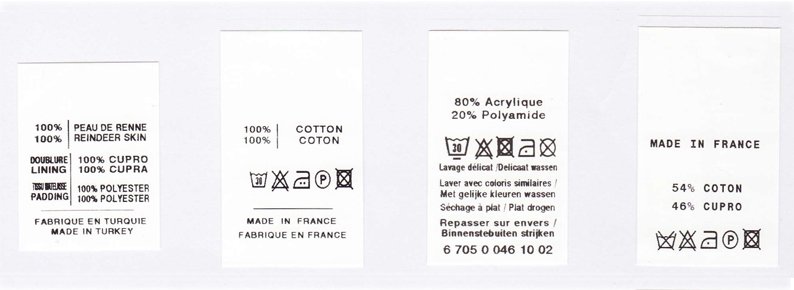We’re well aware that labels irritate us! It itch, it shows, and you believe it’s pointless most of the time. That is most likely why 70% of individuals cut their labels after purchasing them. However, that label discloses a lot, starting with how to take care of your garments. In addition, however, you have access to a wealth of information, such as the size, origin, composition and label.
1. Source’s comprehension
Given our preference for the local, learning more about the clothing’s origins should pique your curiosity. And that’s fantastic because, if you know how to read between the lines, everything occurs on your textile label. After all, specific formulations might deceive you by combining design and production concepts. This is particularly true with the famous words “Created in France” and “French creation”: The distinction between genesis and creation is subtle here!
It’s crucial to keep in mind that for this information to show on a label, 45 per cent of the product must be created in France. In concrete terms, if this is followed by the phrase “made in China,” it indicates that the design is undoubtedly local, but the manufacturing is done in China.
2. Composition awareness
The knowledge of which materials make up your clothing and its durability, features, and benefits, freely appreciate. Textile fibers are divided into three categories:
Natural fibers: Cotton, linen, leather, angora, and merino wool are natural fibers, either vegetable or animal.
Artificial fibers: These fibers are created by chemically treating natural materials. Certain operations, like viscose manufacturing, can be polluting despite being framed. Others, however, are environmentally friendly, because it is manufactured in a closed-loop such as modal or lyocell.
Synthetic fibers: Chemical molecules (petroleum) are synthesized to create synthetic fibres such as Polyester, acrylic, elastane and polyamide.
The goal is to understand each fiber have their qualities and life cycle period. Sustainable fashion takes the life cycle and forecasts the processing of textile waste into account. Natural and artificial fibers are both biodegradable but not synthetics. Therefore, mixtures of materials are more or less virtuous. It’s all up to you to choose the material which is beneficial for your brand and environment.
3. Care symbols
They are as complicated as they are beneficial, as being properly understood is a method of clothing through time and reduces environmental impacts. Unfortunately, a thorough explanation of the symbols’ rigorous control would be too time-consuming, but here in Griffes Vivienne, we make things easy for you.
You only need to know that every symbol refers to a particular indicator of washing, blanching, drying, etc. Clothes are like our best friends. We need to treat them well so that you have a good and long healthy connection. Premature garment usage is often primarily caused by repeated washing at high temperatures. Particularly since some natural fibers, like wool, have self-laving qualities that eliminate the need for washing. So make sure you don’t overdo it! You have to comprehend these symbols to be sure that you are not misled, and you will found that your garments are always sunshine.
4. Label’s understanding
On garment labels, there are a plethora of labels that may be indicated. They certify to businesses’ environmental or social responsibilities in the garment manufacturing process. Here in Griffes Vivienne, We make textile labels extremely handy as you see them. So, before you cut them, keep in mind that they convey the narrative of your clothing and that you might be called an “ethical fashioner” because of them.


